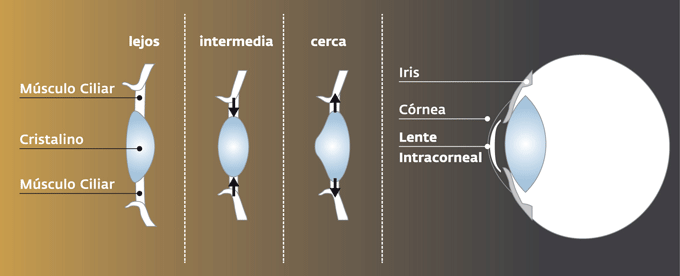
What are they?
They are completely transparent lenses with a 2 mm diameter, which are placed in a centred position on the cornea so that its asphericity is changed. In this way a change in depth of focus can be achieved that combats the difficulty to focus in near vision, a typical symptom of presbyopia.
This option is easily reversible by removing the lens and, if it is decided to be suitable, it is replaced for another lens or other options are proposed that exist at present to combat the effects of presbyopia. Intracorneal lenses are used to combat difficulty to focus in near vision, typical of Presbyopia or “old eyes”.
In which cases is it carried out?
The crystalline lens, the eye’s natural lens, requires two indispensable qualities to fulfil its function: elasticity, in order to “adapt” and be able to focus on objects at different distances, and transparency, to be able to see clearly. In a young person with no ocular problems, both of these qualities are fulfilled.
However, the crystalline lens ages relatively early. From 40 years of age, it gradually loses its properties: it first loses its elasticity and hence its capacity to adapt, which leads to increasing difficulty to focus on near objects (presbyopia). After this, the crystalline lens begins to lose its transparency (cataracts), causing a loss of far and near visual acuity.
Cataract surgery has become the most common ophthalmological surgery carried out in developed societies, more and more people wishing to end their excessive dependence on glasses due to presbyopia. In this respect, IMO is a pioneer in Spain in applying new intracorneal lenses that lack optical power since they do not change the dioptres, but directly affect the corneal curvature.
Previous examinations:
A full ophthalmological examination
Before the surgical operation
These patients should be aware that, even though the power of adaptation of the crystalline lens is not corrected, there are however more and more strategies to reduce its consequences.
During the surgical operation
The surgical operation consists of placing an intracorneal lens that changes the corneal curvature to compensate the crystalline lens’ lack of adaptation.
Risks
It should be borne in mind that this is a process that is in constant evolution and hence most correction techniques should be changed from time to time.
For this reason, specialists focus more and more on techniques that allow reversibility, in other words, once the procedure has been carried out it can be easily changed back with no trauma for the patient, if the results are not those expected or if the evolution of the presbyopia process means this is advisable.
Associated pathologies
Experts performing this treatment
FAQs
Nowadays, there are several techniques. The most popular for small refractive errors, such as myopia, hyperopia and astigmatism, is LASIK. In special cases there are other options available: phakic lenses, crystalline extraction, intracorneal lenses or intrastromal rings.
IMO Institute of Ocular Microsurgery
Josep María Lladó, 3
08035 Barcelona
Phone: (+34) 934 000 700
E-mail: international@imo.es
See map on Google Maps
By car
GPS navigator coordinates:
41º 24’ 38” N – 02º 07’ 29” E
Exit 7 of the Ronda de Dalt (mountain side). The clinic has a car park with more than 200 parking spaces.
By bus
Autobus H2: Rotonda de Bellesguard, parada 1540
Autobus 196: Josep Maria Lladó-Bellesguard, parada 3191
Autobuses H2, 123, 196: Ronda de Dalt – Bellesguard, parada 0071
How to arrive at IMO from:
IMO Madrid
C/ Valle de Pinares Llanos, 3
28035 Madrid
Phone: (+34) 910 783 783
See map in Google Maps
Public transport
Metro Lacoma (líne 7)
Autobuses:
- Lines 49 & 64, stop “Senda del Infante”
- Line N21, stop “Metro Lacoma”
Timetables
Patient care:
Monday to Friday, 8 a.m. to 9 p.m.
IMO Andorra
Av. de les Nacions Unides, 17
AD700 Escaldes-Engordany, Andorra
Phone: (+376) 688 55 44
See map in Google Maps
IMO Manresa
C/ Carrasco i Formiguera, 33 (Baixos)
08242 – Manresa
Tel: (+34) 938 749 160
See map in Google Maps
Public transport
FGC. Line R5 & R50 direction Manresa. Station/Stop: Baixador de Manresa
Timetables
Monday to Friday, 09:00 A.M – 07:00 PM






